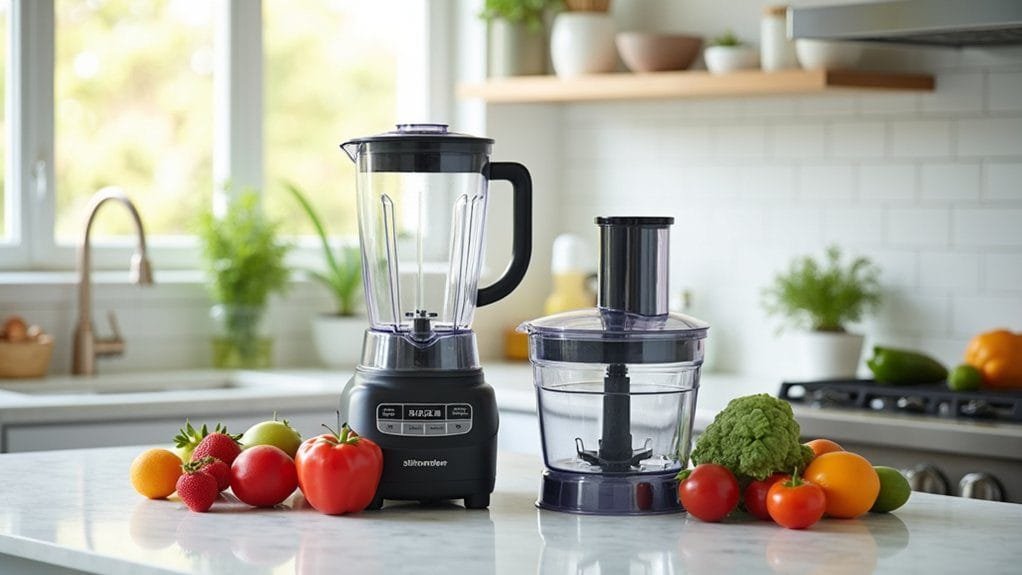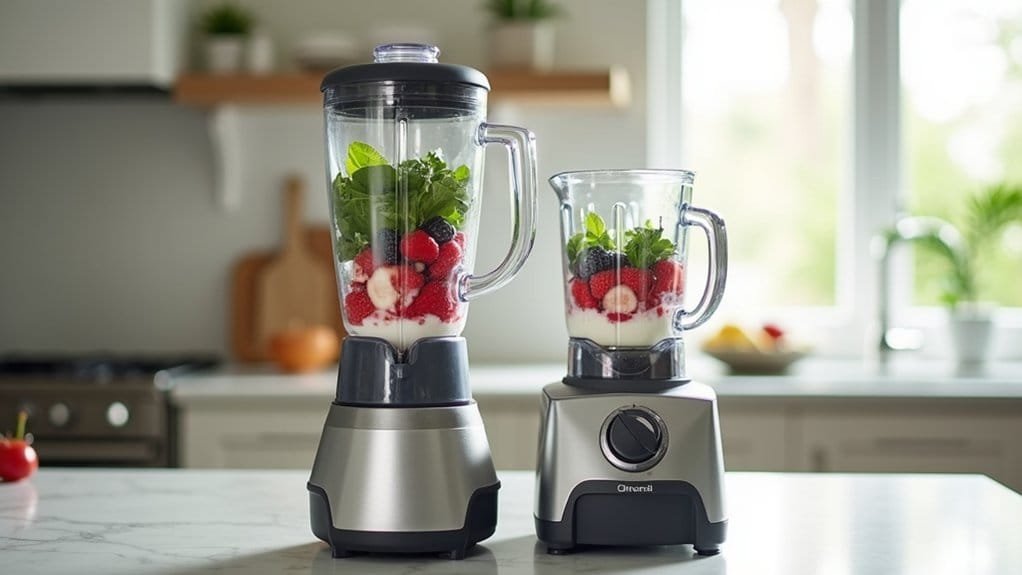You’ll find blenders and food processors serve different kitchen purposes. Blenders excel at creating smooth, liquid-based recipes like smoothies and sauces, using high-speed blades that puree ingredients uniformly. Food processors, with their wider bowls and specialized blades, are designed for chopping, slicing, and mixing dry ingredients, making them ideal for preparing doughs, sauces, and chunky recipes. Your culinary adventure continues beyond this snapshot.
Key Takeaways
- Food processors use specialized S-shaped blades to chop, slice, and shred ingredients while maintaining textural integrity for coarser recipes.
- Blenders are designed to create smooth, liquid-based mixtures like smoothies and sauces by pulverizing ingredients with powerful, mixing-oriented blades.
- Food processors can handle dry, chunky ingredients without added liquid and perform tasks like kneading dough and grinding nuts.
- Blenders require liquid to effectively puree ingredients and excel at creating uniform, creamy textures for beverages, dips, and emulsified sauces.
- The primary difference lies in blade configuration and function: food processors cut and manipulate solid ingredients, while blenders transform ingredients into liquid consistency.
What Is a Food Processor?


Kitchen counters everywhere are home to versatile culinary tools, and the food processor stands out as a powerhouse of food preparation. This kitchen appliance transforms food prep with its powerful S-shaped blades and multiple attachments, enabling you to quickly chop, slice, shred, and puree ingredients with precision. Whether you’re making dough, grinding nuts, or crafting chunky dips like hummus, a food processor adapts to your culinary needs.
Available in sizes ranging from mini (2-5 cups) to large (14-16 cups), these versatile machines offer flexibility for different cooking scales. Feed tubes allow you to incorporate liquids during processing, expanding the appliance’s functionality. Unlike blenders, food processors excel at maintaining textural integrity, making them ideal for recipes requiring a coarser consistency.
What Is a Blender?
The humble blender—a culinary workhorse designed to transform solid ingredients into silky-smooth liquids—stands as a critical tool for home cooks and professional chefs alike. This kitchen appliance leverages powerful blades positioned strategically to create a vortex effect, efficiently pulverizing contents into uniform textures ideal for smoothies, soups, and sauces. Unlike food processors, blenders excel at generating exceptionally creamy dips and drinks by completely breaking down ingredients. High-powered blenders like the Vitamix 5200 push boundaries further, capable of crushing frozen fruit, grinding ice for cocktails, and even producing nut butters when supplemented with liquid. With multiple speed settings and fewer components than food processors, blenders offer versatility and streamlined cleaning, making them an indispensable culinary companion for precision-focused cooking enthusiasts.
Key Differences Between Food Processors and Blenders


When comparing culinary appliances, food processors and blenders diverge considerably in design, functionality, and purpose, making each tool uniquely suited to specific food preparation tasks. Food processors excel at handling chunky ingredients without liquid, utilizing versatile blades for chopping, slicing, and grating. In contrast, blenders rely on liquid to puree ingredients effectively, creating smooth, creamy textures ideal for smoothies and drinks. Their distinct blade configurations set them apart: food processor blades accommodate varied cutting tasks, while blender blades focus on mixing and emulsifying. When choosing between these small kitchen appliances, consider your specific culinary needs. Food processors shine in preparing dips and doughs, maintaining ingredient texture, whereas blenders transform ingredients into uniform, liquid-like consistencies perfect for beverages and sauces.
When to Use a Food Processor
Although versatile culinary tools abound, food processors stand out for specific preparation tasks that demand precision and efficiency. When you’re making dishes that require chopping, slicing, or shredding solid ingredients, a food processor will help you achieve consistent results. Its powerful S-shaped blades excel at pureeing ingredients and creating smooth textures without excessive liquid.
| Task | Food Processor Capability |
|---|---|
| Vegetable Prep | Chop, slice, grate |
| Dough Making | Mix and knead |
| Nut Processing | Chop and grind |
| Sauce Creation | Puree dry ingredients |
Kitchen enthusiasts appreciate food processors for handling larger ingredient quantities and offering multiple attachments. Whether you’re preparing dips, sauces, or complex recipes, these versatile tools outperform blenders when precision and controlled texture are paramount. Their processor lids and specialized blades make complex food preparation seamless and efficient.
When to Use a Blender


Versatile kitchen appliances like blenders shine brightest when liquid-based culinary transformations demand swift, uniform processing. Blenders typically excel in scenarios requiring precise ingredient manipulation:
- Create liquid-heavy mixtures like smoothies, dressings, and cocktails with exceptional consistency
- Purée ingredients into smooth, creamy textures for soups, sauces, and side dishes
- Emulsifying ingredients effectively, producing uniform dips and batters
- Pulverizing frozen fruits and ice while maintaining an ideal, silky composition
High-powered models expand blending capabilities, enabling advanced techniques such as crafting nut butters and hummus. Their compact design and fewer components make them easy to clean, positioning blenders as efficient tools for rapid meal preparation. The appliance’s strength lies in transforming diverse ingredients into uniformly processed, velvety concoctions with minimal effort and maximum precision.
Top Recommended Food Processors
While blenders specialize in liquid-based transformations, food processors emerge as powerhouse kitchen tools designed for precise solid ingredient manipulation. When selecting the best food processor, you’ll want to evaluate models like the Breville Sous Chef series, which offers exceptional performance across different sizes. The Breville 16-Cup model provides robust chopping capabilities, while the 12-Cup version delivers excellent value. For those seeking versatility, the Magimix 14-Cup excels at complex food prep tasks.
If budget is a primary concern, the Cuisinart 14-Cup Processor stands out as a reliable, cost-effective appliance. Unlike a blender, these processors efficiently chop, slice, and even assist in making pastry dough. Mini food processors also offer compact alternatives for smaller kitchen spaces, ensuring you can find a processor tailored to your specific culinary needs.
Top Recommended Blenders
The world of high-performance blenders offers remarkable options for culinary enthusiasts seeking precision and power. When comparing blender brands, you’ll find these top recommendations:
High-performance blenders bring culinary precision and power to your kitchen, with top-tier options for every cooking enthusiast.
- Vitamix 5200: A professional-grade blender available on Amazon for $349, helping you make super smooth smoothies with its powerful motor.
- Breville Fresh & Furious: A budget-friendly option at $200, known for efficiency in blending and handling frozen fruit with ease.
- Vitamix 7500: Features a low-profile design perfect for kitchen tasks, delivering high-speed blending performance in a compact form.
- Vitamix Propel 510: A smaller model priced at $500, ideal for those wanting a powerful yet compact blender.
These options excel where a food processor vs blender comparison might fall short, providing versatility for health-conscious cooking and precise culinary preparation.
Frequently Asked Questions
Is It Better to Have a Blender or a Food Processor?
You’ll want both for complete kitchen versatility: a blender for smoothies and soups, while a food processor efficiently handles chopping, dough mixing, and nut grinding, maximizing your ingredient prep capabilities across different culinary tasks.
Will a Blender Do the Same Job as a Food Processor?
A blender won’t perfectly replace a food processor. While blender versatility shines with liquids, food processor efficiency excels at chopping solids. Their texture differences and ingredient compatibility vary considerably, making each appliance uniquely suited to specific kitchen tasks.
Can a Blender Be Used as a Food Processor?
You can partially use a blender as a food processor, but it’s limited. While excellent for smoothies and purees, it’ll struggle with chopping vegetables, mixing dough, and grinding spices due to different blade configurations and design constraints.
Is It Better to Make Peanut Butter in a Blender or Food Processor?
For creamy, smooth peanut butter, you’ll want a food processor. Its specialized blades and efficient grinding preserve nuts’ oils better than blenders, ensuring ideal texture and preventing over-processing while maintaining the butter’s rich, natural consistency.
Which Blender is More Versatile: Immersion Blenders or Standard Blenders Compared to Food Processors?
When evaluating kitchen tools, the immersion blenders or countertop blenders comparison reveals interesting insights. Immersion blenders offer unmatched flexibility for soups and sauces, while countertop blenders excel in smoothies and ice crushing. A food processor stands out for chopping and slicing, making the choice dependent on your cooking needs.
Conclusion
Just as a Swiss Army knife differs from a scalpel, your kitchen tools serve distinct purposes. Whether you’re channeling your inner Julia Child or prepping for a quick meal, understanding the nuanced capabilities of blenders and food processors will elevate your culinary game. Choose wisely, and you’ll transform your cooking from mundane to magnificent, wielding these appliances like a true kitchen maestro.
